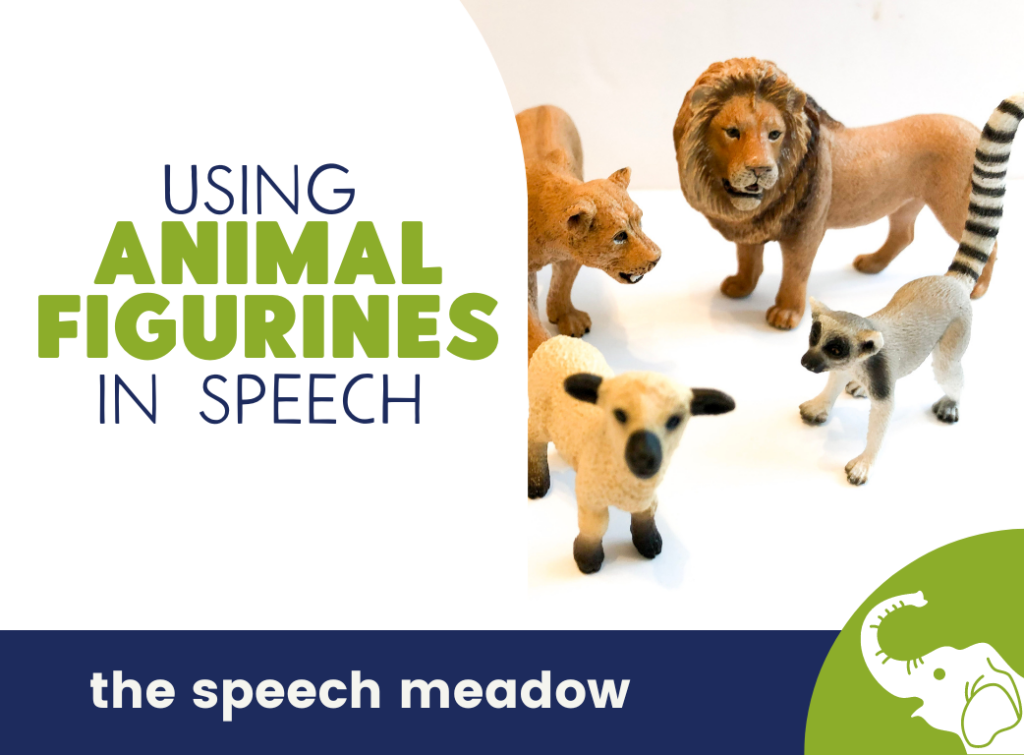Being an SLP, I have a lot of toys and games. I have already talked about how much I love Orchard Toys to work on speech and language skills. One of my other favourite type of toy are figurines. I have a wide range of animals and they pretty much live a school. Here are some ideas on how to use figurines in speech therapy.

Why?
- Children are constantly exposed to animals in the books they read and often in the activities they are exposed to at school.
- Children generally like animals.
- It is so easy to make a game using figurines.
- They are more engaging than worksheets or even pictures of animals.
- Children need to manipulate toys.
- I feel that it helps children learn the language skills they are trying to learn.
Using Figurines in Speech Therapy
Building Vocabulary
I will bring out the animals that are related to the theme in the classroom. In the preschool, we have been talking about farms. All my farm animals have been out along with barns and the kids have been having great fun playing with the animals and making animal noises. They have been invaluable in teaching the animal baby names and what groups of animals are called. For more ideas on how to build a language rich classroom check out this blog post.
Visuals for Songs
Figurines are great to use as visuals although sometimes I wish they were bigger so that they would be easier to see. We have been singing “Old MacDonald” a lot lately. I will have farm animals out so that the children pick what animal we are going to sing about next. The children who are talking will name the animal as they pick it up and hold it. The children who are not talking will take the animal. This way they are able to participate in the song.
Another very popular song at school is the “Alligator Song” (There is an alligator and orangutan, an eagle flying and a silvery fish…) where it names seven different animals. We will have the figurines out while we are singing the song. We will have the children help put the animals in the right order. When the game is done we will play “what’s missing” with those animals.
Categorization
This is a very common activity. Using figurines, the children are able to categorize in a variety of different ways. You can categorize based on where they live, how they move, what they look like, what they eat etc… I find that I tend to get the children moving more when I use figurines as opposed to pictures or worksheets. It’s not uncommon for me to hide animals around the room, down the hall or in the gym and have children run around finding animals and then putting them in their correct category. The set up and the clean up are usually quick, which is a bonus.
Prepositions and Answering “Where” Questions
Here is where working in a three dimensional mode is extremely valuable. The children get to really see how the different objects are related to each other in space. As well being able to physically manipulate objects is very valuable. It is also really easy to make it game. The animals often play “hide and seek” or will line up for something to eat.
Teaching Basic Concepts
I quite often use figurines for teaching big/little, same/different, spots/stripes etc… Again the children are able to see and touch the animals. This allows them to experience these concepts with more of their senses which helps them learn the concepts better.
Conversation Starters
Children like to talk about their favourite animals and tell you why. “E.g. I like bears because they have really really sharp teeth” Using the figurines as visuals, help the children pick an animal. This might be difficult without a figurine being present.
Describing Skills
I will often play “I spy” with the different animals. The children will both guess the answers and describe the animals. Again I will sometimes place the animals around the area we are doing therapy. The children then have to hold the verbal information while looking for the animal which helps work on their memory.
Similarities and Differences
I will frequently have the children group animals as they like them. Then they will tell why the animals are the same and different. This can be challenging for them as sometimes the animals are not that related or are very closely related.
Retelling Stories
This is a great way for children to re-tell stories or nursery rhymes. The children will often take the figurines and other objects and re-enact the stories they have learnt in class. This helps them better understand the story and helps with sequencing.
These are the most common ways I use animal figurines in speech therapy. How do you use them?
